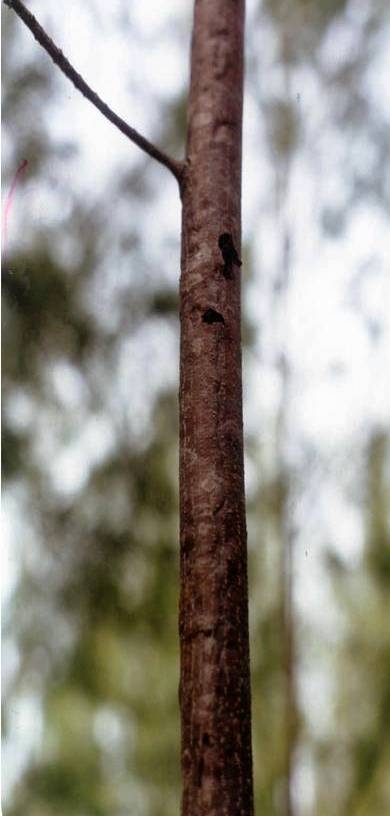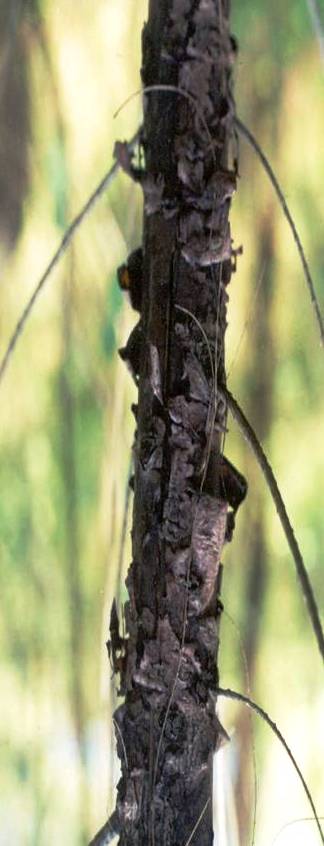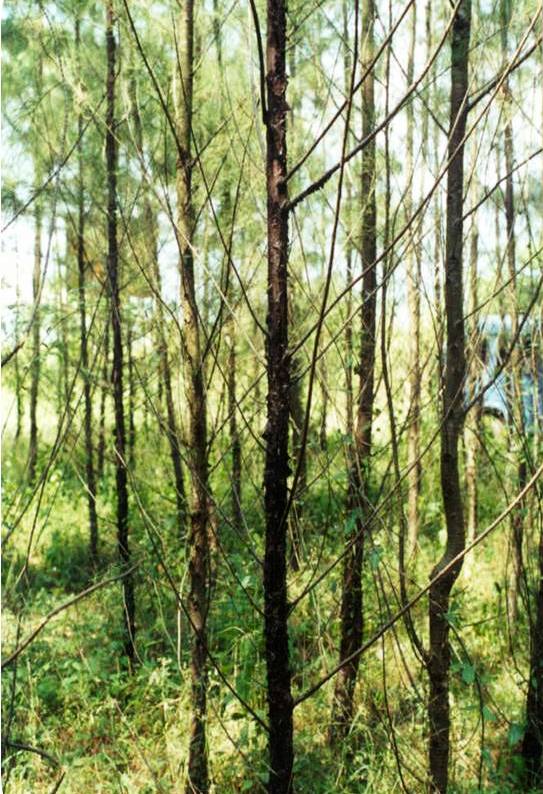This is one of the dreadful diseases causing severe mortality on Casuarina equisetifolia in young and mature plantations in coastal as well as inland plantations in different parts of the country.
Stem wilt or blister bark disease causes
severe mortality on Casuarina
equisetifolia in different age groups of plantations.
Subramanianospora vesiculosa (=Trichosporium vesiculosum) causes mortality in Casuarina equisetifolia.
a) The disease is characterized by yellowing of needles, which is an early symptom of the affected trees.
b) Subsequently, drying of needles, branches and main stem is observed rapid wilting, browning and die-back of tree either singly or in groups follow.
c) Epicormic shoots sometimes occur on the stem after initial wilting and drying of foliage, however, these shoots invariably die off. It is usual for trees to die within a year of the first visible symptoms.
d) In the advanced stage of the disease, small blisters are noticed on the main stem and roots. Blisters develop on the bark due to formation of spore mass beneath the bark. The blisters eventually rupture in the form of scales or flakes and the black powdery mass of spores, appearing like charcoal dust, becomes exposed. When the bark splits open, the blisters burst open to expose the black spores. The blisters are formed by the pressure from proliferation within the live bark of the conspicuous black sooty conidial spore-masses of T. vesiculosum.
e) The infection is found to occur mostly on lateral roots and spread further to the healthy neighbouring trees through root contact. Since the disease spreads by root contact, diseased trees occur in groups.
f) Disease may subsequently spread outwards from the initial foci in the plantation and may be recognized in affected stands by the characteristic formation of firm (not papery) raised blistering of the bark on some of the dead trees, of variable size and shape and coalescing lengthwise along the trunk or branches.
1. Inappropriate and heavy lopping and pruning of branches should be stopped to prevent the primary establishment of the blister bark disease in plantations. If the disease has already secured a foot hold in a plantation, its spread can be checked by trenching the diseased tree which occur in groups.
2. In diseased plantations where mortality occurs every year, the dead and diseased trees should be removed and burnt as early as possible.This will remove the source of infection and thereby minimize incidence of the disease.
3. Severely affected trees should immediately be removed and burnt for preventing the spread of the disease.
4. Selection and breeding for resistance against the said disease and use resistant varieties.
5. Use of bio-control agents such as Trichoderma spp. and Pseudomonas spp. and ectomycorrhizal and AM fungi along with the potting medium in the pits before planting.
Stem wilt or Blister bark disease on Casuarina equisetifolia caused by Subramanianospora vesiculosum(Trichosporium vesiculosum)

Stem wilt or Blister bark disease on Casuarina equisetifolia caused by Subramanianospora vesiculosum(Trichosporium vesiculosum)

Stem wilt or Blister bark disease on Casuarina equisetifolia caused by Subramanianospora vesiculosum(Trichosporium vesiculosum)

Stem wilt or Blister bark disease on Casuarina equisetifolia caused by Subramanianospora vesiculosum(Trichosporium vesiculosum)




